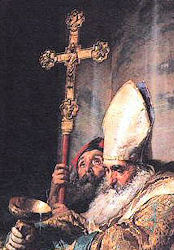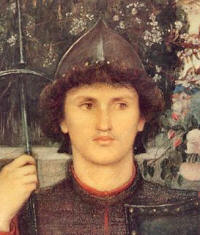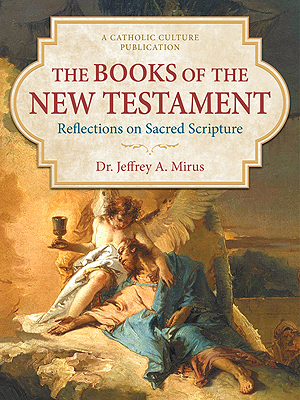Easter: April 23rd
Tuesday of the Fourth Week of Easter; Opt. Mem. of St. George, Martyr; Opt. Mem. of St. Adalbert, Bishop and Martyr
» Enjoy our Liturgical Seasons series of e-books!
The Universal Church celebrates the Optional Memorial of St. George, Martyr (d. 304), which England celebrates this saint as a solemnity. Little is known of him except that he was a soldier and martyr. Veneration of St. George comes from the east, probably from Palestine where he was held in high honor as a martyr. Regarded as the patron of Christian armies, he is venerated under this title by the Latins as well as by the Greeks. He is also included as one of the Fourteen Holy Helpers.
The Optional Memorial of St. Adalbert, Archbishop (957-997) is a recent addition to the USA liturgical calendar. St. Adalbert was ordained the Bishop of Prague in 983. During his episcopate he encouraged the evangelization of the Magyars. Having founded the monastery of Brevnov, he was forced into exile by the nobility of Prague. He tirelessly preached the Gospel in Poland, Hungary, Russia, and Prussia, where he was martyred at the age of 41.
Meditation: Tuesday of the Fourth Week of Easter
The Divine Goodness
1. "The earth is full of the goodness of the Lord." The sacred liturgy cries out today in admiration at the goodness of God. The very purpose and end of the creation of the universe was to communicate the divine goodness to creatures. No mere creature, of course, is capable of receiving the full measure of the divine goodness, and no mere finite being is capable of reflecting all the beauty of God, yet "the earth is full of the goodness of God." But perhaps the goodness of God is more perfectly reflected by the diffusion of the infinite perfection of the Creator among many creatures. This would no doubt account for the staggering variety so evident in the universe. By the prodigal communication of His goodness to His creatures, the divine Artist gives them a faint notion of His infinite perfection and beauty.
2. "The earth is full of the goodness of the Lord, alleluia: by the word of the Lord were the heavens made, alleluia, alleluia." The story of the creation of the world is a beautiful story. Why the universe was created we know; when it was created we can only conjecture. Faith assures us that the world did not exist from all eternity; the world is not coeternal with God; it is His creature and came into being in time. Many modern scientific discoveries are taken by their discoverers as proofs from reason of the beginning of the world at some definite time. While it may be that the age of the universe is indicated by geological strata and similar evidence, this evidence is only an indication and not a valid proof from reason. Neither the eternity of the world nor its beginning in time, St. Thomas tells us, can be proved from reason. Since God's creative action was free, and since He existed from all eternity, He could have created from all eternity, or He could have created in time. Whether the world was created from all eternity or was created in time, does not change the fact that it was created, and that it was created to reflect the goodness and beauty of God. The sacred liturgy is not much concerned with the question of when the world was created; it leaves that to the scientist and the philosopher to discuss. It is fully occupied with the thought of the goodness of God in filling the world with His divine perfection. "The earth is full of the goodness of the Lord." 3. "I am the good shepherd." Perhaps no more striking figure could have been chosen to express the goodness of God as manifested in the incarnation of the Son of God, than that of the good shepherd. Our Lord was accustomed to choose figures of speech and illustrations which could be easily grasped by the people to whom He preached. The picture of the shepherd caring for his sheep on the hills of Palestine was a familiar one to the people of that day. There is something very charming about the idea of a man caring tenderly for a group of foolish, errant, improvident animals such as sheep. The shepherd by his very nature is far superior to the animals he cares for. It is an act of great condescension for him to devote his time and his labor to the welfare of his sheep. But what our Lord was trying to tell us was that God is like that. He stands infinitely above His creatures, and yet there is no limit to the solicitude He has for them.
The extent of the solicitude of the Good Shepherd, Christ, for His human sheep, is outlined for us by St. Paul in the Epistle: "Who His own self bore our sins in His body upon the tree: that we being dead to sins, should live to justice: by whose stripes you were healed. For you were as sheep going astray: but you are now converted to the shepherd and bishop of your souls." But solicitude on the part of the Shepherd is not enough. The sheep must respond to this solicitude with faith and confidence in His concern for their salvation. Even God cannot save us unless we cooperate with Him. This is true also of the bishops and priests appointed by Christ to carry on His work in this world. The bishops and priests too, are solicitous for the salvation of their flocks. But they must have the cooperation of the people or their efforts will be in vain.
—Benedict Baur, OSB, The Light of the World, Vol. 2
St. George
St. George is venerated by the Eastern Church among her "great martyrs" and "standard-bearers." He belonged to the Roman army, was arrested and, probably, beheaded under Diocletian, c. 304. He is the patron of England, since 800. St. George is one of the "Fourteen Holy Helpers."
Many legends are attached to Saint George, the most famous is in The Golden Legend with the dragon. There was a dragon that lived in a lake near Silena, Libya. Not even armies could defeat this creature, and he terrorized flocks and the people. St. George was passing through and upon hearing about a princess was about to be eaten, he went to battle against the serpent, and killed it with one blow with his lance. Then with his great preaching, George converted the people. He distributed his reward to the poor, then left the area.
Patronage: against herpes; against leprosy; against the plague; against skin diseases; against skin rashes; against syphilis; lepers; agricultural workers; archers; armourers; arms manufacturers; boxers; butchers; castle chapels; cavalry in general; French and Italian cavalry; chivalry; equestrians; farmers; field hands; field workers; fighters; halberdiers; horsemen; horses; husbandmen; knights; pugilists; riders; saddle makers; saddlers; sheep; shepherds; soldiers; wrestlers
See CatholicSaints.info for listing of locations and organizations for patronage.
Symbols and Representation: Armor; buckler; dragon.
Highlights and Things to Do:
- Read more about St. George:
- Christian Iconography has some beautiful images of St. George.
- See the Statue of St. George on St. Peter's Basilica Colonnade.
- This article from Historic UK gives information on St. George, the growth and influence of legends about him in England and his place in English history.
- Learn more about St. George and scouting.
- See Catholic Cuisine for food ideas for St. George.
- Read more about the Fourteen Holy Helpers
Saint Adalbert
 St. Adalbert while still under thirty became bishop of Prague, but the pastoral and political difficulties were such that in 990 he withdrew in desperation to Rome. Pope John XV sent him back to his diocese, where he founded the great abbey of Brevnov; but again he met with opposition to his ministry from the nobility, and again he retired to Rome. At length it became apparent that there was no hope of his working unmolested in Prague, and he was allowed to turn his attention to the heathen Prussians of Pomerania. But here he had no more success. He and his fellow missionaries nevertheless persevered in their mission, and were eventually murdered, perhaps near Konigsberg. Despite the disappointments of his career, St Adalbert of Prague seems to have had considerable influence. He was a friend of the Emperor Otto III, encouraged the evangelization of the Magyars, and inspired St Boniface of Querfurt; his cultus was widespread in central Europe. He in his turn was influenced by the ideals of the great monastery of Cluny.
St. Adalbert while still under thirty became bishop of Prague, but the pastoral and political difficulties were such that in 990 he withdrew in desperation to Rome. Pope John XV sent him back to his diocese, where he founded the great abbey of Brevnov; but again he met with opposition to his ministry from the nobility, and again he retired to Rome. At length it became apparent that there was no hope of his working unmolested in Prague, and he was allowed to turn his attention to the heathen Prussians of Pomerania. But here he had no more success. He and his fellow missionaries nevertheless persevered in their mission, and were eventually murdered, perhaps near Konigsberg. Despite the disappointments of his career, St Adalbert of Prague seems to have had considerable influence. He was a friend of the Emperor Otto III, encouraged the evangelization of the Magyars, and inspired St Boniface of Querfurt; his cultus was widespread in central Europe. He in his turn was influenced by the ideals of the great monastery of Cluny.
Patronage: Bohemia; Czech Republic; Northern Slavs; Poland; Prussia; archdiocese of Esztergom-Budapest, Hungary; archdiocese of Gniezno, Poland; archdiocese of Prague, Czech Republic; Cormons, Italy; city of Prague, Czech Republic
Symbols and Representation: holding a two-headed cross, two lances, and a club; holding a lance with a club at the lower end; pierced by three lances and beheaded; baptizing Saint Stephen of Hungary; chains at his feet; angels carrying him to heaven; stabbed with a lance; a globe of fire hovering over his tomb
Highlights and Things to Do:
- Read this homily by John Paul II from the Catholic Culture Library about St. Adalbert.
- Read more about St. Adalbert:
- If you are interested in heraldry you may view several images here.
- Saints in Rome details about St. Adalbert's relics in St. Vitus Cathedral in Prague.
- Read about the mystery of St. Adalbert's resting place.








